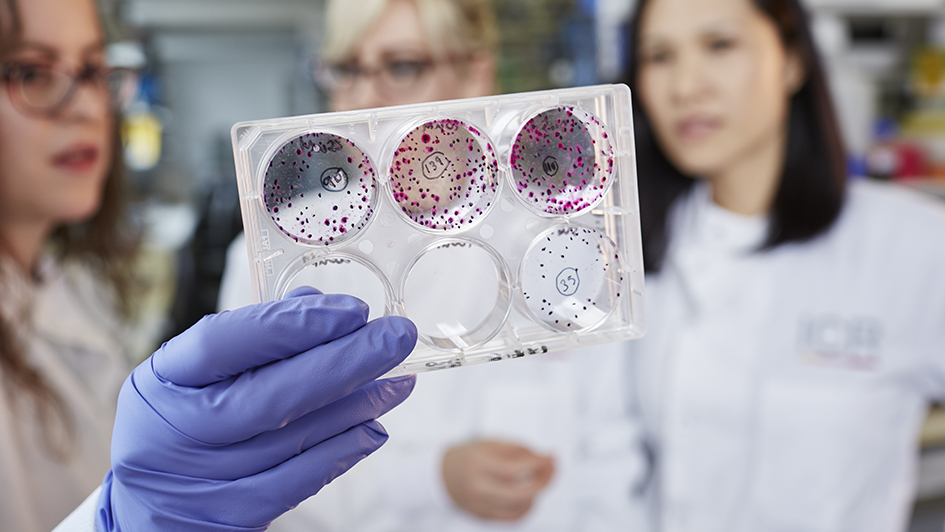
Image: Multi-well cell culture plate held by a scientist. Credit: John Angerson
Last week, I attended the War on Cancer conference, which was part of London Global Cancer Week. It was a great opportunity for me to hear about the policy work happening across the world for cancer research and care, and to learn how priorities can differ depending on a population’s needs.
One session, a panel discussion involving our Chief Executive Professor Paul Workman, was on the topic of regulatory innovation. This caught my attention because it so closely linked to some of the work we’ve been doing here at The Institute of Cancer Research.
Regulatory innovation sounds like an oxymoron – how can you be truly innovative if you’re bound by rules and regulations? This is exactly what the session looked to unpick.
Over the past few years, the armamentarium available to us for cancer treatment and care has grown exponentially. Immunotherapy is making great leaps to the clinic, genomics has broadened the potential for personalised medicine, and Big Data and AI are helping us find ways to tackle cancer evolution.
Regulators are now facing a new challenge, in which they must manage the flow into clinical practice – balancing speed of access to new treatments with their role in ensuring safety and efficacy.
We’ve been doing a lot of work at the ICR around innovation recently, and this session made me think about some of the key challenges in creating, trialling and making available more effective cancer treatments as fast as is safely possible.
The importance of prioritising innovation
In order for us to really break the mould in our efforts to treat cancer, we need regulators to prioritise the most innovative cancer treatments that have the greatest potential to deliver step-change advances for patients.
Currently, too many drugs under development have similar mechanisms of action to others already on the market and only offer incremental benefits to patients. We need drugs that work against a wider range of targets, through novel mechanisms of action, to be fast tracked into NHS use.
How do we achieve this change? For starters, many new therapies are taking too long to reach patients. Often, regulators need to see evidence of an increase in ‘overall survival’ from large-scale phase III clinical trials before approving drugs. However, assessing overall survival – the length of time after starting treatment that a patient is still alive – can take years.
We’d like to see a wider variety of measures being used to assess the effectiveness of new treatments. Particularly measures that focus on patient experience – such as quality of life and the amount of time a drug prevents their cancer from progressing.
Ideally, we need academia and industry to work together to validate a series of surrogate endpoints that are accepted within the NICE technology appraisal process, rather than waiting for mature overall survival data.
At the ICR, we also believe we need to broaden the definition of innovation that NICE uses not only to cover the current definition of effectiveness in an area of unmet clinical need, but also to recognise the importance of developing treatments that tackle cancer in brand new ways.
By having a shared recognition of what a highly innovative treatment looks like, NICE can get better at assessing whether, for example, a drug is innovative in its design, its target, the diseases it is effective against, or the way it is used or delivered.
Our 2018 drug access report, From Patent to Patient, highlights the progress that is being made with discovering exciting new cancer medicines. But it also draws attention to key challenges that will need to be overcome to ensure more patients can benefit from these advances.
The benefit of combination treatments
One crucial issue raised by Professor Paul Workman during the session was that of cancer evolution – the ability of cancer cells to adapt, in a Darwinian fashion, to evade treatment. Without addressing cancer evolution, we are at risk of flooding the market with treatments that won’t work in the long term.
A multi-faceted approach to cancer treatment, involving several different drugs or immunotherapies together for example, can make it harder for the disease to evolve and become drug resistant – just as we have achieved with treatment combinations for tuberculosis and HIV. The regulatory system needs to make it easier for pharmaceutical and biotech companies to test treatments in combination.
Somewhat frustratingly, companies are legally unable to work together to price drug combinations because competition laws prevent them from sharing the prices of individual drugs. This can make using drugs in combination unaffordable for the NHS.
Whilst there is no straightforward solution to this, government and regulators could be more flexible. It’s important to make a clear case to the Competition and Markets Authority that suspending the competition law could help potentially life-saving combination treatments reach patients more quickly.
Embracing personalised medicine
Over the last decade, cancer research has increasingly utilised advances in genetics to create new forms of precision medicine – a way of tailoring therapies for individual patients and their specific tumour. This is a move away from standard care pathways used currently on the NHS, and is revolutionising the way we treat many types of cancer.
To target a treatment so precisely, it is essential to gain detailed information about a patient and their cancer, and that requires the use of biomarkers. These are measurable indicators that help us detect things such as early signs of cancer, how aggressive it is, what are some of the key mutations responsible and how a patient is likely to respond to treatment.
To fully embrace personalised medicine, we need to see regulations that encourage the development and use of biomarkers – in research, clinical trials and routine patient care. Ideally, each new precision medicine should be accompanied by a predictive biomarker test which can guide treatment by telling us early whether or not a drug is likely to work, enabling clinicians to switch up the treatment approach if not.
A future-proof regulatory landscape
At the ICR, we have been calling for many of the points above for a while now – highlighting many in our Cancer Drugs Manifesto and our wider work around innovation. While we certainly don’t have all the answers, we are hoping to encourage the right conversations that could lead to real change.
We are making real progress with finding new treatments for cancer, and enabling patients to live longer and fuller lives with the disease.
We now need a regulatory environment to encourage this progress – one that is sufficiently agile to keep pace with the scientific advances we are seeing now and will be seeing much more of in the future.
